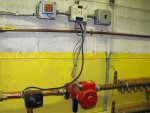Jim Caudill
Self Serve Operator
I tried several different ways to make my underfloor heating more economical; the only one that worked was shutting it off, period. A 500,000btu boiler will use aproximately 5ccf or 5 therms per operating hour. Depending on where you live, you either buy ccf's (me) or therms (lots of other places). Take a look at your last winter gas bills and see what you paid (per ccf or therm) with all charges and taxes added together. If you paid $2, then your heater will cost you $10per hour in natural gas while the boiler is actually firing. You can play with slabstats, dual thermostats, return line sensing all you want, but at my wash, once the temp falls below about 20degrees, you're all-in, all the time. The only thing that you're being regulated by, is the limit switches.
If you spend most of your winter above 20 degrees, then some of this stuff may work for you. When it gets cold, it really doesn't matter- you're going to "pay the piper". I don't get enough winter revenue to make it practical to heat the floor anymore.
If you spend most of your winter above 20 degrees, then some of this stuff may work for you. When it gets cold, it really doesn't matter- you're going to "pay the piper". I don't get enough winter revenue to make it practical to heat the floor anymore.








